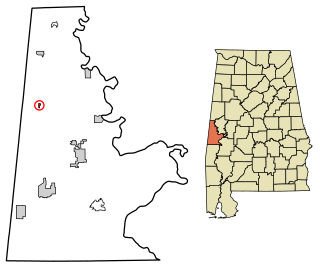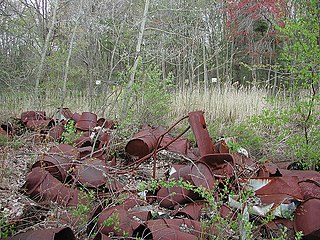
Emelle is a town in Sumter County, Alabama, United States. It was named after the daughters of the man who donated the land for the town. The town was started in the 19th century but not incorporated until 1981. The daughters of the man who donated were named Emma Dial and Ella Dial, so he combined the two names to create Emelle. Emelle was famous for their great cotton. The first mayor of Emelle was James Dailey. He served two terms. The current mayor is Roy Willingham Sr. The population was 53 at the 2010 census, up from 31 in 2000.

Toxic waste is any unwanted material in all forms that can cause harm. Mostly generated by industry, consumer products like televisions, computers, and phones contain toxic chemicals that can pollute the air and contaminate soil and water. Disposing of such waste is a major public health issue.

Superfund is a United States federal environmental remediation program established by the Comprehensive Environmental Response, Compensation, and Liability Act of 1980 (CERCLA). The program is administered by the Environmental Protection Agency (EPA). The program is designed to investigate and clean up sites contaminated with hazardous substances. Sites managed under this program are referred to as "Superfund" sites. There are 40,000 federal Superfund sites across the country, and approximately 1,300 of those sites have been listed on the National Priorities List (NPL). Sites on the NPL are considered the most highly contaminated and undergo longer-term remedial investigation and remedial action (cleanups).

Love Canal is a neighborhood in Niagara Falls, New York, United States, infamous as the location of a 0.28 km2 (0.11 sq mi) landfill that became the site of an enormous environmental disaster in the 1970s. Decades of dumping toxic chemicals harmed the health of hundreds of residents; the area was cleaned up over the course of 21 years in a Superfund operation.

Environmental racism or ecological apartheid is a form of institutional racism leading to landfills, incinerators, and hazardous waste disposal being disproportionally placed in communities of color. Internationally, it is also associated with extractivism, which places the environmental burdens of mining, oil extraction, and industrial agriculture upon indigenous peoples and poorer nations largely inhabited by people of color.

Illegal dumping, also called fly dumping or fly tipping (UK), is the dumping of waste illegally instead of using an authorized method such as curbside collection or using an authorized rubbish dump. It is the illegal deposit of any waste onto land, including waste dumped or tipped on a site with no license to accept waste. The United States Environmental Protection Agency developed a “profile” of the typical illegal dumper. Characteristics of offenders include local residents, construction and landscaping contractors, waste removers, scrap yard operators, and automobile and tire repair shops.
Environmental justice is a social movement to address the unfair exposure of poor and marginalized communities to harms from hazardous waste, resource extraction, and other land uses. The movement has generated hundreds of studies showing that exposure to environmental harms is inequitably distributed.

Munisport Landfill is a closed landfill located in North Miami, Florida adjacent to a low-income community, a regional campus of Florida International University, Oleta River State Park, and estuarine Biscayne Bay.

Warren County PCB Landfill was a PCB landfill located in Warren County, North Carolina, near the community of Afton south of Warrenton. The landfill was created in 1982 by the State of North Carolina as a place to dump contaminated soil as result of an illegal PCB dumping incident. The site, which is about 150 acres (0.61 km2), was extremely controversial and led to years of lawsuits. Warren County was one of the first cases of environmental justice in the United States and set a legal precedent for other environmental justice cases. The site was approximately three miles south of Warrenton. The State of North Carolina owned about 19 acres (77,000 m2) of the tract where the landfill was located, and Warren County owned the surrounding acreage around the borders.
Urban sociology is the sociological study of social life and human interaction in metropolitan areas. It is a normative discipline of sociology seeking to study the structures, processes, changes and problems of an urban area and by doing so providing inputs for planning and policy making.

Shpack Landfill is a hazardous waste site in Norton, Massachusetts. After assessment by the United States Environmental Protection Agency (EPA) it was added to the National Priorities List in October 1986 for long-term remedial action. The site cleanup is directed by the federal Superfund program. The Superfund site covers 9.4 acres, mostly within Norton, with 3.4 acres in the adjoining city of Attleboro. The Norton site was operated as a landfill dump accepting domestic and industrial wastes, including low-level radioactive waste, between 1946 and 1965. The source of most of the radioactive waste, consisting of uranium and radium, was Metals and Controls Inc. which made enriched uranium fuel elements for the U.S. Navy under contract with the U.S. Atomic Energy Commission. Metals and Controls merged with Texas Instruments in 1959. The Shpack landfill operation was shut down by a court order in 1965.

Moyer's Landfill was a privately owned landfill in Collegeville, Pennsylvania, United States. It was originally farmland outside the town. In the 1940s, the owner started accepting trash and municipal waste as a way to make additional money. The original landfill was 39 acres and did not have a liner to protect the land from contaminate. A liner was added to a new section in the late 1970s. Over time, the landfill accepted sewage, and industrial wastes which contained hazardous substances in addition to municipal waste. The site was closed by the EPA in 1981, and was one of the first "Superfund" sites added to the National Priorities List.
Environmental privilege is a concept in environmental sociology, referring to the ability of privileged groups to keep environmental amenities for themselves and deny them to less privileged groups. More broadly, it refers to the ability of privileged groups to keep an exclusive grip on the advantages of "social place," including non-ecological amenities. It has been characterized as "the other side of the coin" from environmental racism. Like other forms of racial privilege, it does not depend on personal racism, but rather structural racism. Environmental privilege is a consequence of both class and racial privilege with respect to access to the overall environment, influencing the social and economic realm. It is the result of cultural, economic, and political power being wielded. It provides exclusive access to environmental facilities such as elite neighborhoods that contain exclusive rivers, parks, and open areas to particular people. These groups are more likely to participate in sustainable efforts and have access to premium amenities. Furthermore, during the COVID-19 epidemic, wealthy communities were able to better adhere to safety protocols.
Environmental, ecological or green gentrification is a process in which cleaning up pollution or providing green amenities increases local property values and attracts wealthier residents to a previously polluted or disenfranchised neighbourhood. Green amenities include green spaces, parks, green roofs, gardens and green and energy efficient building materials. These initiatives can heal many environmental ills from industrialization and beautify urban landscapes. Additionally, greening is imperative for reaching a sustainable future. However, if accompanied by gentrification, these initiatives can have an ambiguous social impact. For example, if the low income households are displaced or forced to pay higher housing costs. First coined by Sieg et al. (2004), environmental gentrification is a relatively new concept, although it can be considered as a new hybrid of the older and wider topics of gentrification and environmental justice. Social implications of greening projects specifically with regards to housing affordability and displacement of vulnerable citizens. Greening in cities can be both healthy and just.
Guam v. United States, 593 U.S. ___ (2021), was a U.S. Supreme Court case dealing with a dispute on fiscal responsibility for environmental and hazardous cleanup of the Ordot Dump created by the United States Navy on the island of Guam in the 1940s, which Guam then ran after becoming a territory in 1950 until the landfill's closure in 2011. The Supreme Court ruled unanimously that under the Comprehensive Environmental Response, Compensation, and Liability Act of 1980, Guam had filed its lawsuit to recover a portion of cleanup costs for the landfill from the United States government in a timely manner, allowing their case to proceed.

Dumping in Dixie is a 1990 book by the American professor, author, activist, and environmental sociologist Robert D. Bullard. Bullard spotlights the quintessence of the economic, social, and psychological consequences induced by the siting of noxious facilities in mobilizing the African American community. Starting with the assertion that every human has the right to a healthy environment, the book documents the journey of five American communities of color as they rally to safeguard their health and homes from the lethal effects of pollution. Further, Bullard investigates the heterogeneous obstacles to social and environmental justice that African American communities often encounter. Dumping in Dixie is widely acknowledged as the first book to discuss environmental injustices and distill the concept of environmental justice holistically. Since the publication of Dumping in Dixie, Bullard has emerged as one of the seminal figures of the environmental justice movement; some even label Bullard as the "father of environmental justice".
Environmental racism is a form of institutional racism, in which people of colour experience environmental harms, such as pollution and the effects of natural disasters, at a disproportionately high rate. Some scholars have coined environmental racism as the "New Jim Crow". Like Jim Crow laws, environmental racism systematically disenfranchises black people. It causes devastating impacts on the physical and mental health of African Americans, and creates disparities in many different spheres of life, such as transportation, housing, infrastructure, health, and economic opportunity. Epidemiologists Joel Kaufman and Anjum Hajat argue that, "discriminatory policies and practices that constitute environmental racism have disproportionately burdened communities of color, specifically African-Americans, Native Americans, Asian Americans and Pacific Islanders, and Hispanic populations."

Ordot Dump, also known as Ordot Landfill, was a landfill on the western Pacific island of Guam that operated from the 1940s until 2011. Originally operated by the U.S. military, ownership was transferred to the Government of Guam in 1950, though it continued to receive all waste on the island, including from Naval Base Guam and Andersen Air Force Base, through the 1970s.

Environmentalism of the poor is a set of social movements that arise from environmental conflicts when impoverished people struggle against powerful state or private interests that threaten their livelihood, health, sovereignty, and culture. Part of the global environmental justice movement, it differs from mainstream environmentalism by emphasizing social justice issues instead of emphasizing conservation and eco-efficiency. It is becoming an increasingly important force for global sustainability.














